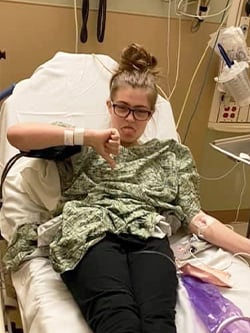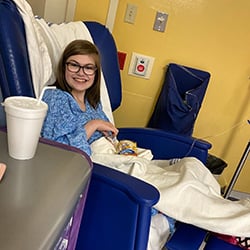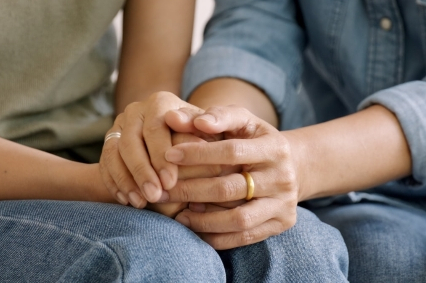Endometriosis: Taylor’s Story
Meet Taylor

Thirteen-year-old Taylor Stewart looks like the picture of health, but looks can be deceiving. Behind her big, beautiful smile and bubbly personality is a teen who once described herself as “constantly miserable and in pain,” and until recently, she didn’t know why.
Taylor’s pain started shortly after her 12th birthday and seemed connected to her menstrual cycles. “I started having abdominal pain that was more intense than regular cramps,” Taylor said. And the pain was debilitating.
“Taylor probably spent 50% of her time in bed or on the couch, lying on a heating pad with terrible cramps and crying,” said her mom, Amber Stewart. “Her periods were awful, and when they were over, she didn’t feel up to doing anything the rest of the month.”
Concerned about Taylor’s health, Amber took her to their local pediatrician who performed some basic tests, then referred her to a gastroenterologist.
In the meantime, Taylor seemed to be getting sicker and sicker. “Taylor went from a healthy 126 pounds down to 99 pounds over 15 months,” Amber added. “She loves to babysit, but didn’t feel up to it, and she stopped participating in church activities.”
Taylor didn’t feel like eating, was nauseous, throwing up, sweaty, clammy and sometimes shook from pain. And pain relievers, like ibuprofen, didn’t do anything to help.
“The Fall 2020 semester, I missed almost everything,” Taylor said. “Over Thanksgiving and Christmas, I didn’t even want to get off the couch. I was in so much pain.”
Meanwhile, Taylor went through several gastrointestinal tests, including a colonoscopy and an endoscopy, but the results were all normal.
Desperately seeking answers

Desperate for answers, Amber decided Taylor needed to see someone who specializes in gynecology. “I found information on the Children’s Mercy website, so I scheduled an appointment,” Amber said. “Nothing else seemed to be helping.”
The Lawrence, Kan., teen had her first appointment with the Children’s Mercy Gynecology team at the end of December 2020.
The Children’s Mercy Endometriosis Care program is one of the few comprehensive programs in the nation. Here, patients with endometriosis can be diagnosed and treated, helping them manage their symptoms so they can live normal, active lives, and improving functional outcomes.
After listening to Taylor’s health history and learning more about her symptoms, the Children’s Mercy team told Taylor they suspected she had endometriosis.
Endometriosis is an ongoing condition that happens when uterine tissue grows outside the uterus, especially in the abdominal and pelvic areas. According to the Endometriosis Association, it often begins with the start of menstrual periods and can change over time.
In the United States, it is estimated that 6.5 million women and girls as young as 8 suffer from endometriosis, and 89 million worldwide.1
“Many people, even medical professionals, think of endometriosis as a condition that affects women in their 20s,” Taylor’s physician said. “But we’re increasingly recognizing that endometriosis can happen in young girls like Taylor.”
The most common symptoms are painful menstrual periods, cramping and lower abdominal pain, nausea, vomiting, changes in bowel movements and urination. While mild cramping may be common with normal menstrual cycles, endometriosis pain is severe, does not respond to the usual mild pain relievers or hormone therapy, and over time, may lead to daily pelvic pain, all symptoms Taylor had.
Plus, Taylor’s mom had been diagnosed with endometriosis when she was younger, too. “My case was not as severe as Taylor’s,” Amber said. “But a family history can be a risk factor.”
Comprehensive care

The Children’s Mercy Endometriosis Care program includes a team of experts from multiple disciplines, all trained to specifically address endometriosis in teens.
The program’s multidisciplinary approach includes laparoscopic diagnosis and removal of endometriosis, medical management and hormone therapy, physical and occupational therapy, pain management and psychological support to help teens handle the challenges associated with endometriosis.
“Every patient’s case is different,” Taylor’s physician said. “That’s why it’s very important to customize the patient’s treatment plan to their needs.”
In Taylor’s case, she had already tried two different types of birth control pills by the time she saw the endometriosis care team, but she had not gotten any relief from them.
The doctor “explained that some girls achieve better pain control with an intrauterine device, or IUD, than with the pill,” Amber said.
An IUD is a T-shaped plastic frame that's inserted into the uterus where it releases the hormone progestin, which can reduce severe menstrual pain and pain related to endometriosis.
Taylor was willing to give the IUD a try, and she liked the Children’s Mercy team’s proactive approach to her care.
“The IUD is placed during laparoscopic surgery, so the doctor said while she was in there, she could take a look around and see how bad the endometriosis was,” Taylor said. If she found anything, she could use a laser to remove the overgrowth of endometrial tissue during the same outpatient procedure.
“We don’t know the prevalence of endometriosis in teens, but in most studies, if we look at teens with a constellation of signs and risk factors like Taylor’s, we’ll find endometriosis about 75% of the time,” Taylor’s physician explained.
Amber scheduled Taylor’s outpatient surgery for Jan. 20, 2021. The Children’s Mercy team placed the IUD as planned, and using a laparoscope, a thin telescope-like instrument inserted through a small incision near the belly button, removed the endometrial tissue that they found.
“Taylor has very advanced disease for a 13-year-old girl,” her physician said. “Our hope is that by removing as much of the endometriosis as we could, and implanting the IUD, she’ll achieve significant pain relief.”
Feeling much better!

Already, Taylor is feeling much better, enjoying activities she had given up before surgery, like babysitting in the church nursery and her appetite has returned. She was even up for a shopping trip a few days after surgery, something she hasn’t felt like doing for a long, long time.
“Mom took me shopping with my Christmas gift cards,” Taylor said. “We went to four stores and I shopped for two hours. I felt this burst of energy. It was great!”
Taylor will continue as a patient in the Children’s Mercy Endometriosis Care program. The team will continue to monitor her symptoms and treatment until she reaches age 18.
Going forward, Taylor may take advantage of some of the other services the Endometriosis Care program offers, such as physical and occupational therapy or pain management techniques, like biofeedback.
“At her post-op appointment, Taylor’s doctor validated things for her, encouraged her to take this disease seriously and not to worry about whether anyone else understands it—to do what she needs to do to take care of herself,” Amber said.
Taylor agreed that being a teen with endometriosis isn’t easy. “It’s hard to tell my friends that I have this disease and that sometimes I don’t feel like doing anything,” Taylor added. “I look fine from the outside, but I can’t just take a couple of ibuprofen and feel better. It’s not easy to explain.”
“Taylor’s case was pretty typical of the patients we see,” Taylor’s physician added. “Our goal is that early diagnosis can improve functional outcomes in teens and reduce the disability that many girls with endometriosis experience.”
Amber wants to encourage other parents to be proactive in finding care for their teen. According to the Endometriosis Association, it takes an average of over nine years to receive a correct diagnosis and treatment. This means that much of a child’s youth may be spent suffering unexplained, often crippling pain.1
“A lot of medical professionals don’t think someone Taylor’s age could have such severe endometriosis,” Amber said. “Taylor was lucky we found her doctor at Children’s Mercy.
“After her surgery, it was a huge relief to know what she has is real, that there is a name for it, and that we have a plan to manage it,” Amber said. “If you have a gut feeling that something isn’t right with your child, follow your instincts.”
Taylor agreed. “I’m glad that we found out what I have, and that my doctor could treat it. To say that I feel good sounds like such a small word, but it’s a very big deal for me.”
For more information about the Children’s Mercy Endometriosis Care program, call (816) 234-4151.
References
- Endometriosis Association website. Accessed July 3, 2020. https://endometriosisassn.org/
Endometriosis: Avery and MK’s story
Siblings Avery and MK both struggled with the pain of endometriosis. Holistic care from the Children’s Mercy Gynecology department has helped them get back to normal teen activities.

